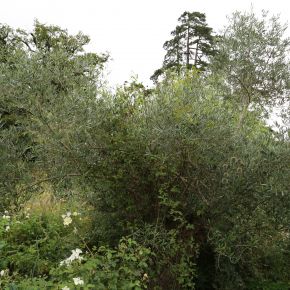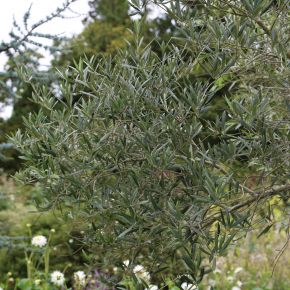Olea europaea
(Olive)
Family - Oleaceae
Category - Tree
Origin - Mediterraean
Season of Interest - Spring, Summer, Autumn, Winter
Hardiness - H4
Height - 3-6m
Width - up to 6m
Location - The White Garden
Description: A small Evergreen tree or large Shrub with slender, upright stems and a rounded outline. Leathery grey-green leaves have silvery-grey undersides and are narrowly Elliptic to lanceolate in shape. The Olive tree is usually grown for the attractive foliage in this climate, not the fruit. Small fragrant flowers with four petals are ivory white. The Blooms are held in Racemes along the branches and produced in late summer. The flowers are followed by green, oval olive fruits that ripen to black. The olives are not usually produced in this climate.
The olive tree is a prevalent figure in symbolism and mythology and is commonly recognised as a symbol of peace.
Flower:
Small, fragrant flowers with four petals are ivory white. The blooms are in racemes held along the branches and produced in August. The flowers are followed by green, oval, oily fruits that ripen to black. The fruit is rarely produced in this climate.
Flower colour: White
Flower shape: Small four-petalled flowers held in racemes
Flowering time: August
Foliage:
Leathery, grey-green leaves have silvery-grey undersides and are narrowly Elliptic to lanceolate in shape. The leaves are held in opposite pairs along the slender branches.
Foliage Senescence: Evergreen
Foliage Shape: Elliptic to lanceolate
Propagation:
Cuttings, seed.
Cultivation:
Best grown in a warm, sheltered position or under glass. Olea Europaea requires rich, fertile soil that is well-drained.


